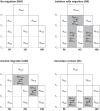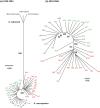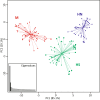Genetic differentiation and evolution of broad-leaved evergreen shrub and tree varieties of Daphniphyllum macropodum (Daphniphyllaceae)
- PMID: 37460735
- PMCID: PMC10462706
- DOI: 10.1038/s41437-023-00637-2
Genetic differentiation and evolution of broad-leaved evergreen shrub and tree varieties of Daphniphyllum macropodum (Daphniphyllaceae)
Abstract
Tree form evolution is an important ecological specialization for woody species, but its evolutionary process with adaptation is poorly understood, especially on the microevolutionary scale. Daphniphyllum macropodum comprises two varieties: a tree variety growing in a warm temperate climate with light snowfall and a shrub variety growing in a cool temperate climate with heavy snowfall in Japan. Chloroplast DNA variations and genome-wide single-nucleotide polymorphisms across D. macropodum populations and D. teijsmannii as an outgroup were used to reveal the evolutionary process of the shrub variety. Population genetic analysis indicated that the two varieties diverged but were weakly differentiated. Approximate Bayesian computation analysis supported a scenario that assumed migration between the tree variety and the southern populations of the shrub variety. We found migration between the two varieties where the distributions of the two varieties are in contact, and it is concordant with higher tree height in the southern populations of the shrub variety than the northern populations. The genetic divergence between the two varieties was associated with snowfall. The heavy snowfall climate is considered to have developed since the middle Quaternary in this region. The estimated divergence time between the two varieties suggests that the evolution of the two varieties may be concordant with such paleoclimatic change.
© 2023. The Author(s), under exclusive licence to The Genetics Society.
Conflict of interest statement
The authors declare no competing interests.
Figures





Similar articles
-
Comparative organelle genomics in Daphniphyllaceae reveal phylogenetic position and organelle structure evolution.BMC Genomics. 2025 Jan 15;26(1):40. doi: 10.1186/s12864-025-11213-9. BMC Genomics. 2025. PMID: 39815181 Free PMC article.
-
Daphmacrimines A-K, Daphniphyllum alkaloids from Daphniphyllum macropodum Miq.Phytochemistry. 2024 Jul;223:114106. doi: 10.1016/j.phytochem.2024.114106. Epub 2024 Apr 23. Phytochemistry. 2024. PMID: 38657885
-
[Altitudinal variation pattern in Daphniphyllum macropodum leaf traits and influencing environmental factors in Mao'er Mountain, China].Ying Yong Sheng Tai Xue Bao. 2023 Dec;34(12):3223-3231. doi: 10.13287/j.1001-9332.202312.002. Ying Yong Sheng Tai Xue Bao. 2023. PMID: 38511360 Chinese.
-
A strong 'filter' effect of the East China Sea land bridge for East Asia's temperate plant species: inferences from molecular phylogeography and ecological niche modelling of Platycrater arguta (Hydrangeaceae).BMC Evol Biol. 2014 Mar 4;14(1):41. doi: 10.1186/1471-2148-14-41. BMC Evol Biol. 2014. PMID: 24593236 Free PMC article.
-
Daphmacromines K-O, alkaloids from Daphniphyllum macropodum.Fitoterapia. 2013 Sep;89:205-9. doi: 10.1016/j.fitote.2013.06.005. Epub 2013 Jun 10. Fitoterapia. 2013. PMID: 23756191
Cited by
-
Evolutionary Histories of Camellia japonica and Camellia rusticana.Ecol Evol. 2024 Dec 24;14(12):e70721. doi: 10.1002/ece3.70721. eCollection 2024 Dec. Ecol Evol. 2024. PMID: 39720636 Free PMC article.
References
-
- Blum MGB, François O. Non-linear regression models for Approximate Bayesian Computation. Stat Comput. 2010;20:63–73. doi: 10.1007/s11222-009-9116-0. - DOI
Publication types
MeSH terms
Associated data
LinkOut - more resources
Full Text Sources

